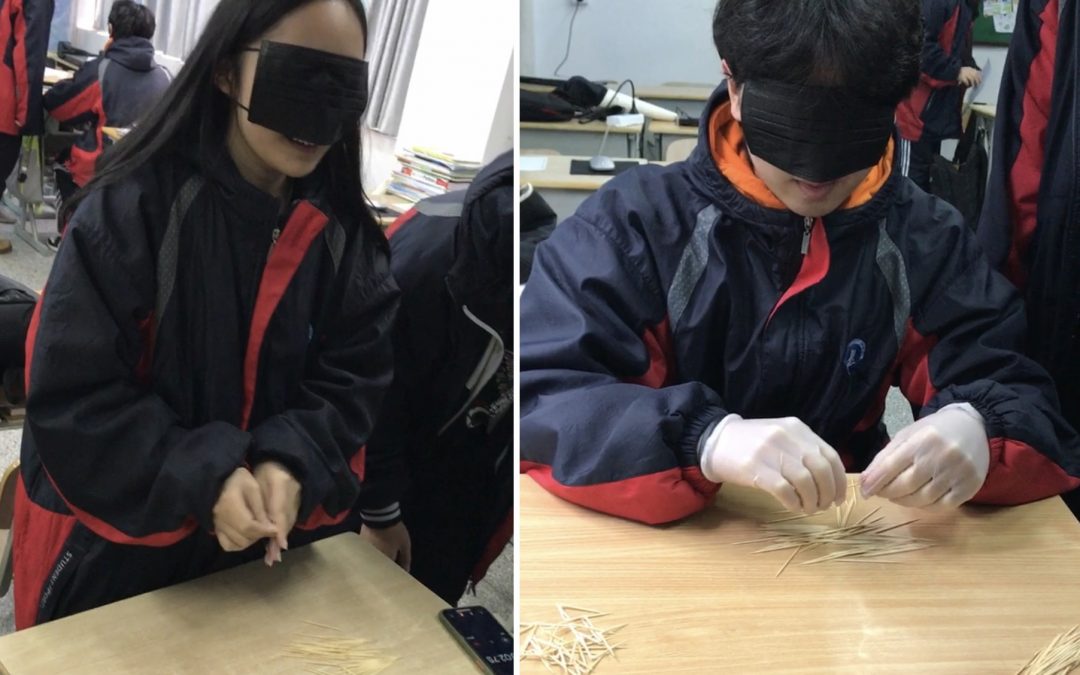By G12 Jewel
As time passes by, we are in the latter part of the first semester. Last week, Mr. Wynnychuk held an interesting and vivid experiment for G12 students.
Every three to four students cooperated to finish the experiment. The teacher provided each group a package of toothpicks to simulate the substrate of the enzyme reaction and asked the students to use their hands to play the role of the enzyme. Regarding one broken toothpick as one reaction, students compared the number of broken toothpicks in various conditions (low-temperature/obstacles) in a limited time, which was also used as the data to calculate the rate.
Participants closed their eyes while they were doing the experiment to do away with the influence of visuals in the accuracy of the data in the experiment. In the first round of the experiment, toothpicks were the only reactant, so every team accomplished the experiment. However, as the experiment continued, the difficulty of the experiment gradually increased. The teacher asked students to mix the iron wire together with toothpicks during the second experiment, which increases the chance of making a mistake. The forecast from the teacher showed the exact result of this experiment, as some students failed to distinguish the two materials, it became harder for them to speed up the reaction.
The most interesting part of the experiment was the “low-temperature environment” in the third experiment. “Before I got the form, I was wondering how we could prepare for the especially cold environment,” said Anna, an experimenter. “When Mr. Wynnychuk carried in a big pot of icy water, I silently prayed for all of my classmates.” It felt mean for Mr. Wynnychuk to ask all the experimenters to soak their hand in the water for two minutes. The experimenters eventually complied to his command, while the recorders were standing on the side, encouraging the participants to overcome this hard task. After suffering for two minutes, the experimenters ran to their group members and started the third experiment right away—their hands completely red. “The experiment finished before I could feel my hand again,” Xin Tong Jiang(江欣彤)said, “It was so cold. I couldn’t even feel the toothpick, even though I held it in my hand. However, I must confess that it was a really interesting experiment. I would call it a ‘vivid experiment’.”
Then Mr. Wynnychuk shared the meaning of this biological stimulation experiment. “I want more students who choose this course to vividly comprehend how the enzymes work because cramming students’ mind with knowledge points and pictures is not a good idea for the graduating class. Remembering things without understanding only puts more pressure on those students. If they get the chance to use their hands with provided materials to finish the experiment freely, then they will have a deeper understanding of the concepts than if they were studying it in a book.” Mr. Wynnychuk also said: “I hope students can regard this experiment as one that is interesting and release some stress. Everyone can learn the knowledge about the enzyme through cooperation, logic, and learning by heart. Biology is definitely never a tedious course!”
Just like Mr. Wynnychuk said, biology is not a monotonous course that can be solved by rigor and repetition, but one that is abundant and diverse in its methodologies. The repetition of such experiments allows us to consolidate our foundation in knowledge, summarize regulation, and go higher and farther in our learning overall.

